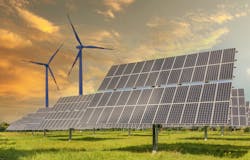Renewable energy is a growing component of the global energy mix, especially for electric power production. According to the International Energy Agency, nearly 10% of the world’s total primary energy supply in 2016 came from biofuels and wastes, and a quarter of the electricity generated was from renewable sources.
Local factors strongly influence the development of renewable energy sources. For example, over 95% of domestic electricity generation in Norway is hydroelectric. This is due largely to the geography and geology of the region. On the other hand, government subsidies and tax incentives, especially in Europe, significantly spurred the growth of wind and solar photovoltaic (PV) power in that region. Access to natural resources, infrastructure, public policy, and commercial pricing of energy streams also play a major part in how different technologies are implemented, and at which locations.
Similar local and regional factors also affect the demand side. Within the chemical industry, companies are taking advantage of the growth of renewables in different ways around the globe. Intense debate also is raging on how renewable energy will affect our industry in the future. The types of changes under consideration fall into two main categories: configuration of energy distribution systems, and impact on process technologies.
Most large chemical plants and oil refineries today are integrated with some form of fossil-fuel-fired cogeneration facility that provides much of the steam and power sites require. Integrating large-scale wind or solar power production directly into existing chemicals sites in a similar way has been widely discussed, but is problematic. These renewable energy sources have a much lower energy density than fossil fuels, and renewable power plants need an order of magnitude more land; there isn’t enough space for them within the battery limits of most existing chemicals sites. Moreover, because of the variability of wind and solar energy, the average power output is much less than the rated output of the power generating equipment, which has to be significantly oversized. This further increases both costs and land requirements. In addition, a site wanting to run purely on solar or wind power requires energy storage systems to smooth the variations in output. This greatly increases both the cost and complexity of large-scale renewable energy plants.
A more-cost-effective option is to build a large, stand-alone wind or solar power plant, interconnected with an electric grid system, to serve the power requirements of nearby chemical plants. For example, in The Netherlands, a green energy purchasing consortium, which includes Nouryon and Royal DSM, take electricity directly from two Dutch wind farms (see, “Chemical Makers Turn to Renewable Energy”). Another example comes from Saudi Arabia where, in May 2019, SABIC, Marafiq, and the Royal Commission for Jubail and Yanbu signed a memorandum of understanding to scope a solar PV plant to provide all the electricity required for SABIC’s chemical sites in Yanbu during the day.
The rise of renewables also likely will shift the industry towards more electrical technologies within the core of its processes. The most obvious example is electrolysis. Electrolysis is best known in large-scale chloralkali production. Other, smaller-scale applications exist, but its industrial use could grow considerably. For example, several European companies have announced plans to produce electrolytic “green hydrogen” (See, “Parties Unite to Develop Green Hydrogen Cluster in Amsterdam”). Electrolytic paths to other industrial products could follow, see, e.g., “Carbon Utilization Gets a Boost."
Indeed, a variety of other electrical and electromagnetic technologies could get a boost from the renewable electrification trend. For example, microwave-enhanced chemistry, where microwave heating is used in reaction systems, has been known since the 1950s. Its benefits include increased rate and yield, and improved selectivity, in some small-scale applications. However, it has not been widely adopted at industrial scale.
New research is focusing on other forms of electrical and electromagnetic technologies to intensify process heating, improve product properties, and even eliminate thermal demands entirely in some cases. Possible applications include, but are not limited to, curing of composites and carbon-fiber-reinforced plastics, accelerating polymerization processes, and drying heat-sensitive materials such as textiles and plastics.
About the Author

Alan Rossiter
Energy Columnist
Alan Rossiter is a former contributor for Chemical Processing's Energy Saver column. He has more than 35 years of experience in process engineering and management, including eight years in plant technical support, design and research with Imperial Chemical Industries (ICI, United Kingdom) and nine years in energy efficiency and waste minimization consulting with Linnhoff March, before starting his own business. In 2019 he joined the University of Houston as Executive Director, External Relations for UH Energy. He is a chartered engineer (U.K.) and a registered professional engineer in the state of Texas. His latest book, Energy Management and Efficiency for the Process Industries, coauthored with Beth Jones, was published by John Wiley & Sons in 2015. He is a Fellow of the American Institute of Chemical Engineers and a Past Chair of the South Texas Section of the AIChE.
